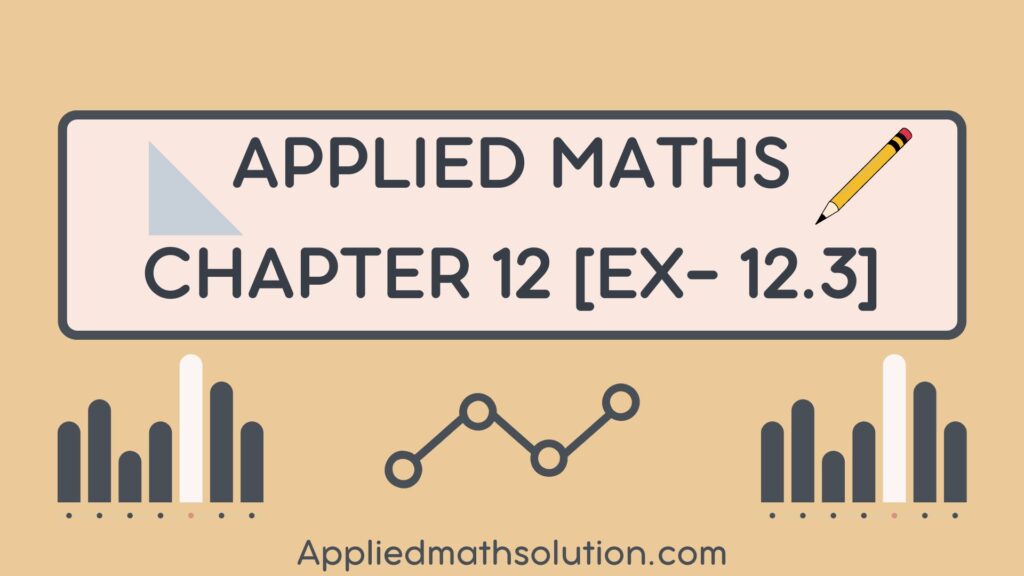Welcome to Class 12 Applied Maths Chapter 12, where we embark on an exciting journey into the world of advanced mathematical concepts tailored for Class 11 students.” Unlock the power of applied mathematics with expert solutions crafted by professionals at AppliedMath.com. Designed to propel students towards academic success, our meticulously curated ML Aggarwal Solutions for Applied Mathematics cater to Class 11 and class 12 students seeking mastery in their examinations. Every query from the CBSE ML Aggarwal Books finds a comprehensive answer on our platform, complete with detailed explanations and step-by-step solutions presented in an easily understandable language.
Dive into the world of applied mathematics and discover how our resources can elevate your understanding and performance. Keep reading to explore the wealth of ML Aggarwal Solutions for Class 11 and Class 12 Applied Mathematics.
Here we provide you with Class 12 Applied Maths Chapter 12, to help you gain a comprehensive understanding of the chapter and its concepts. https://appliedmathsolution.com/wp-admin/post.php?post=6&action=edit

Class 12 Applied Maths Chapter 12 Solutions
Perpetuity, Sinking Funds and EMI
EXERCISE- 12.3
Q.1 Rahul borrowed Rs.100000 from a co-operative society at the rate of 10% p.a. for 2 years. Calculate his EMI using flat rate method.
Ans. Interest = (P x R x T)/100
= (100000 x 10 x 2)/100
= Rs.20000
EMI = (P + I)/n
Where, P = Principal
I = Interest
n = Number of EMI
EMI = (100000 + 20000)/(2 x 12)
= 120000/24
= Rs.5000
Q.2 Calculate the EMI under ‘Flat rate system’ for a loan of Rs.5,00,000 with 10% annual interest rate for 5 years.
Ans. Interest = (P x R x T)/100
= (500000 x 10 x 5)/100
= Rs.250000
EMI = (P + I)/n
Where, P = Principal
I = Interest
n = Number of EMI
EMI = (500000 + 250000)/(5 x 12)
= 750000/60
= Rs.12500
Q.3 Jyoti buys a car for which she makes down payment of Rs.3,50,000 and the balance is to be paid in 3 years by monthly instalments of Rs.34,000 each. If the financer charges interest at the rate of 12% per annum and uses flat rate method, find the actual price of the car.
Ans. EMI = Rs.34000, T = 3 years, R = 12%
Interest = (P x R x T)/100
= (P x 12 x 3)/100
= 9/25p
EMI = (P + I)/n
Where, P = Principal
I = Interest
n = Number of EMI
34000 = (P + 9/25P)/(3 x 12)
34000 x 36 = 34/25 P
P = (34000 x 36 x 25)/34
= Rs.900000
Actual Price = 900000 + 350000
= Rs.125000
Q.4 Mrs. Dubey borrowed Rs.500000 from a bank to purchase a car and decided to repay by monthly installments in 5 years. The bank charges interest at 8% p.a. compounded monthly. Calculate the EMI. (Given (1.0067)60 = 1.4928)
Ans. P = Rs.500000, n = 5 x 12 = 60, i = 8/12% = 0.0067
EMI = [P x i x (1 + i)^n]/[(1 + i)^n – 1]
= [500000 x 0.0067 x (1 + 0.0067)^60]/[(1 + 0.0067)^60 – 1]
= (3350 x 1.4928)/(1.4928 – 1)
= (3350 x 1.4928)/0.4928
= Rs.10147
Q.5 Utkarsh purchased a laptop worth Rs.80000. He paid Rs.20000 as cash down and balance in equal monthly installments in 2 years. If bank charges 9% p.a. compounded monthly. Calculate the EMI. (Given (1.0075)24 = 1.1964)
Ans. P = 80000 – 20000 = Rs.60000
n = 2 x 12 = 24, i = 9/12% = 0.0075
EMI = [P x i x (1 + i)^n]/[(1 + i)^n – 1]
= [60000 x 0.0075 x (1 + 0.0075)^24]/[(1 + 0.0075)^24 – 1]
= (450 x 1.1964)/(1.1964 – 1)
= (450 x 11964)/1964
= Rs.2741.24
Q.6 Mr. Bharti wishes to purchase a flat for Rs.6000000 with a down payment of ₹1000000 and balance in equal monthly payments for 20 years. If bank charges 7.5% p.a. compounded monthly, calculate the EMI. (Given (1.00625)^240 = 4.4608)
Ans. P = 6000000 – 1000000 = Rs.5000000
n = 20 x 12 = 240, i = 7.5/12% = 0.00625
EMI = [P x i x (1 + i)^n]/[(1 + i)^n – 1]
= [5000000 x 0.00625 x (1 + 0.00625)^240]/[(1 + 0.00625)^240 – 1]
= (31250 x 4.4608)/(4.4608 – 1)
= (31250 x 4.4608)/3.4608
= Rs.40279
Q.7 Mr. Dharmendra Patel purchased a motorcycle of Rs.150000 with Rs.25000 down payment. He wishes to repay balance in equal monthly payments in 4 years. If bank charges 9% p.a. compounded monthly, calculate the EMI. (Given (1.0075)48 = 1.4314)
Ans. P = 150000 – 25000 = Rs.125000
n = 4 x 12 = 48, i = 9/12% = 0.0075
EMI = [P x i x (1 + i)^n]/[(1 + i)^n – 1]
= [125000 x 0.0075 x (1 + 0.0075)^48]/[(1 + 0.0075)^48 – 1]
= (937.5 x 1.4314)/(1.4314 – 1)
= (937.5 x 1.4314)/0.4314
= Rs.3110.66
Q.8 Surjeet purchased a new house, costing Rs.40,00,000 and made a certain amount of down payment so that he can pay the balance by taking a home loan from XYZ Bank. If his equated monthly installment is ₹30,000 at 9% interest compounded monthly (reducing balance method) and payable for 25 years, then what is the initial down payment made by him? [Use (1.0075)-300 = 0.1062]
Ans. EMI = Rs.30000, n = 25 x 12 = 300, i = 9/12% = 0.0075
EMI = [P x i]/[1 – (1 + i)^-n]
30000 = [P x (1 + 0.0075]/[(1 – (1 + 0.0075)^-300]
30000 = (P x 0.0075)/(1 – 0.1062)
30000 = (P x 0.0075)/0.8938
P = (30000 x 8938)/75
= Rs.3575200
Down payment = 4000000 – 3575200
= Rs.424800
Q.9 A person amortizes a loan of ₹150000 for a new home by obtaining a 10 year mortgage at the rate of 12% compounded monthly. Find
(i) EMI.
(ii) Total interest paid (Given a120/0.01 = 69.6891).
Ans. (i) P = Rs.150000, n = 10 x 12 = 120, i = 12/12 = 1% = 0.01
EMI = P/an/i
= 150000/a120/0.01
= 150000/69.9891 = Rs.2152.42
(ii) Total interest paid = 120 x 2152.42 – 150000
= 258290.40 – 150000
= Rs.108290.40
Q.10 A loan of ₹400000 at the interest rate of 6.75% p.a. compounded monthly is to be amortized by equal payments at the end of each month for 10 years. Find
(i) the size of each monthly payment.
(ii) the principal outstanding at the beginning of 61st month.
(iii) the interest paid in 61st payment.
(iv) the principal contained in 61st payment.
(v) total interest paid.
(Given (1.005625)120 = 1.9603, (1.005625)60 = 1.4001)
Ans. P =400000, i = 6.75/12% = 0.005625, n = 10 x 12 = 120
(i) EMI = [P x i x (1 + i)^n]/[(1 + i)^n – 1]
= [400000 x 0.005625 x (1 + 0.005625)^60]/[(1 + 0.005625)^60 – 1]
= (2250.0 x 1.9603)/(1.9603 – 1)
= (2250 x 1.9603)/0.9603
= 4593.01 = 4593
(ii) Principal beginning of 61st month
= EMI x [(1 + i)^(n-k+1) – 1]/[i x (1 + i)^(n-k+1)]
= [4593 x (1 + 0.005625)^(120-61+1) – 1]/[0.005625 x (1 + 0.005625)^(120-61+1)
= [4593 x (1.4001 – 1)]/(0.005625 x 1.4001)
= (4593 x 0.4001)/(0.005625 x 1.4001)
= 233336.89
(iii) Interest paid in 61st payment
= EMI x [(1 + i)^(n-k+1) – 1]/[(1 + i)^(n-k+1)]
= [4593 x (1 + 0.005625)^(120-61+1) – 1]/[(1 + 0.005625)^(120+61-1)
= [4593 x (1.4001 – 1)]/1.4001
= (4593 x 0.4001)/1.4001
= Rs.1312.52
(iv) Principal = EMI – Interest
= 4593 – 1312.52
= Rs.3280.48
(v) Total Interest = EMI x n – P
= 4593 x 120 – 400000
= 551160 – 400000
= Rs.151160
Q.11 A person amortizes a loan of Rs.1500000 for renovation of his house by 8 years mortgage at the rate of 12% p.a. compounded monthly. Find
(i) the equated monthly installment.
(ii) the principal outstanding at the beginning of 40th month.
(iii) the interest paid in 40th payment.
(iv) the principal contained in 40th payment.
(v) total interest paid.
(Given (1.01)96 = 2.5993, (1.01)^57 = 1.7633)
Ans. P = 1500000, i = 12/12% = 0.01, n = 8 x 12 = 96
(i) EMI = [P x i x (1 + i)^n]/[(1 + i)^n – 1]
= [1500000 x 0.01 x (1.01)^96]/[(1.01)^96 – 1]
= (15000 x 2.5993)/(2.5993 – 1)
= (15000 x 25993)/15993
= 24379.10
(ii) Principal beginning of 40t5 month
= EMI x [(1 + i)^(n-k+1) – 1]/[i x (1 + i)^(n-k+1)]
= [24379.10 x (1 + 0.01)^(96-40+1) – 1]/[0.01 x (1 + 0.01)^(96-40+1)
= [24379.10 x (1.7633 – 1)]/(0.01 x 1.7633)
= (24379.10 x 0.7633)/(0.01 x 1.7633)
= 1055326.20
(iii) Interest paid in 40th payment
= EMI x [(1 + i)^(n-k+1) – 1]/[(1 + i)^(n-k+1)]
= [24379.10 x (1 + 0.01)^(96-40+1) – 1]/[(1 + 0.01)^(96-40+1)
= [24379.10 x (1.7633 – 1)]/1.7633
= (24379.10 x 0.7633)/1.7633
= 10553.26
(iv) Principal = EMI – Interest
= 24379.10 – 10553.26
= Rs.13825.84
(v) Total Interest = EMI x n – P
= 24379.10 x 96 – 1500000
= Rs.840393.6
FAQ’s related to Class 12 Applied Maths Chapter 12 on Perpetuity, Sinking Funds and EMI:
Q.1 What is a perpetuity?
Ans. A perpetuity is a type of annuity that pays a fixed amount of money indefinitely. Unlike typical annuities that end after a set period, perpetuities have no end date.
Q.2 What is a sinking fund?
Ans. A sinking fund is a fund established to save money over time for a future expense or to pay off a debt. Regular contributions are made to this fund, which earns interest, to accumulate enough to meet the intended obligation.
Q.3 What are the practical applications of sinking funds?
Ans. Sinking funds are commonly used by companies to pay off debt, like bonds, to replace assets, or to fund large future expenses. Individuals may use sinking funds to save for goals like buying a car or paying for a weddi
Q.4 What is EMI?
Ans. EMI stands for Equated Monthly Installment. It is a fixed payment amount made by a borrower to a lender at a specified date each month. EMIs are used to pay off both interest and principal over a specific period.
Q.5 What is an amortization schedule?
Ans. An amortization schedule is a table detailing each periodic payment on a loan (typically a mortgage), showing the amount of principal and interest that comprise each payment until the loan is paid off at the end of its term.
These are a few Frequently Asked Questions relating to Class 12 Applied Maths Chapter 12
In Class 12 Applied Maths chapter 12, you will explore fascinating topics that form the backbone of practical problem-solving techniques. Through clear explanations, illustrative examples, and step-by-step solutions, you’ll grasp complex concepts effortlessly. Whether you’re preparing for exams or simply eager to deepen your mathematical understanding, Class 12 Applied Maths Chapter 12 promises an enriching learning experience that will set you on the path to success. Class 12 Applied Maths Chapter 12, we delve deep into advanced mathematical concepts that are crucial for understanding.


